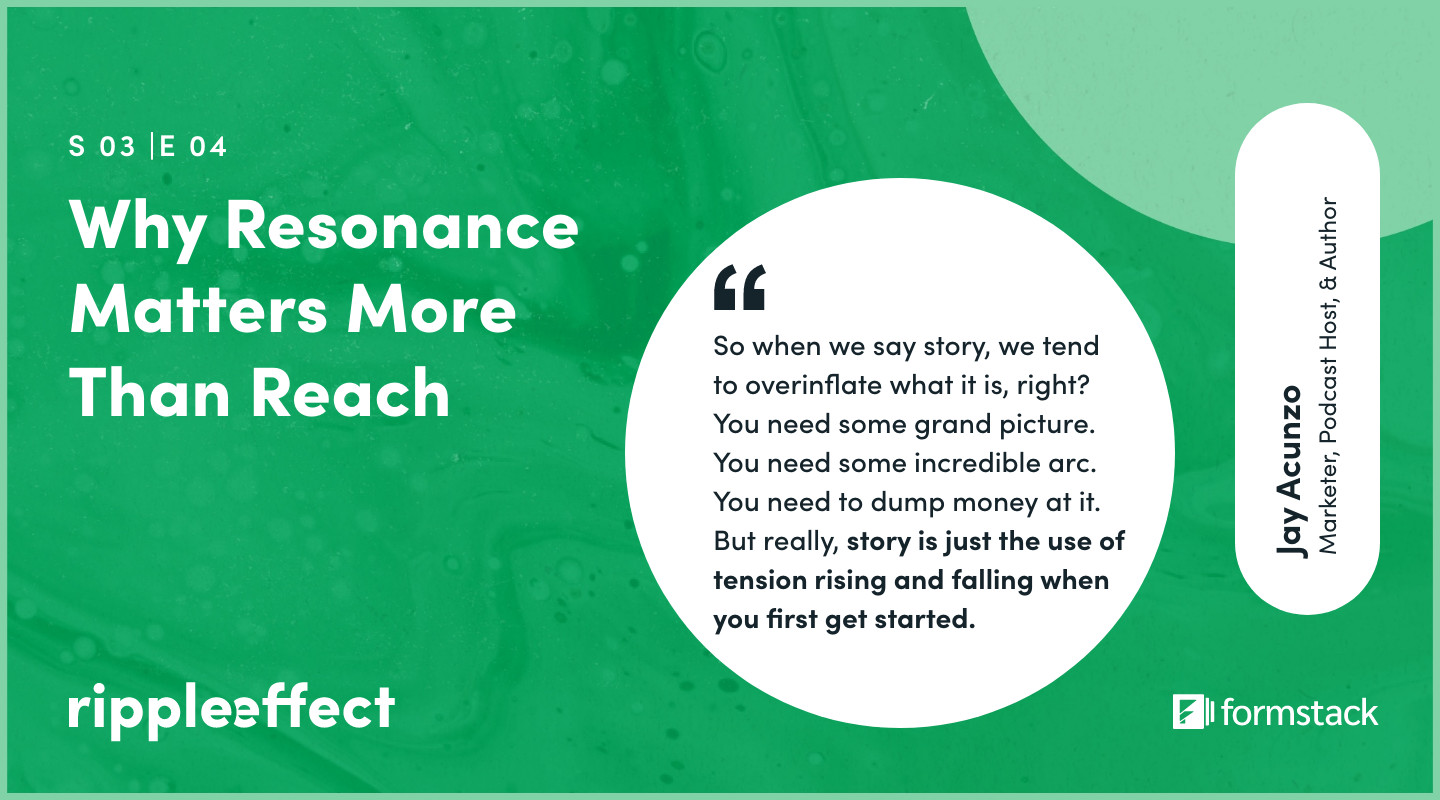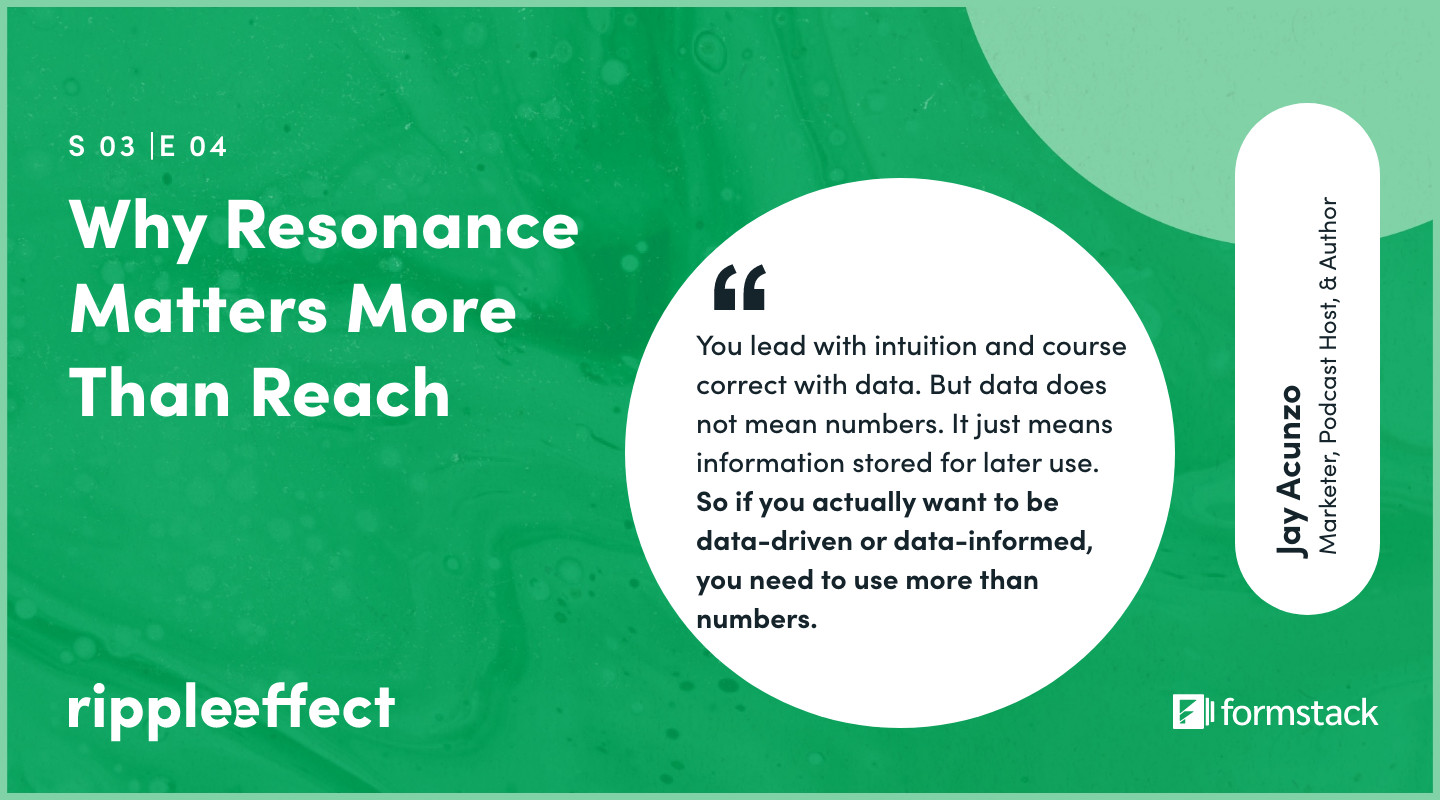“I saw this willingness to kind of just ship nothingness, to just look like everybody else.”
This is a quote from marketer and podcast host Jay Acunzo. He recently joined Formstack CEO Chris Byers on the Ripple Effect podcast episode Why Resonance Matters More Than Reach to discuss his journey into marketing. Over the years, Jay has developed a unique point of view that breaks away from many marketing best practices to help brands overcome common, boring, and ineffective marketing tactics.
So how does Jay cut through the noise and help brands stand out? What strategies has he used to help renown B2B companies build their brands, content, stories, and voices? Below are just a few of his best marketing tips shared during the episode.

Listen Now: Hear all of Jay’s excellent marketing tips, tricks, and advice by listening to his Ripple Effect episode Why Resonance Matters More Than Reach now.
1. Focus on resonance more than reach.
A lot of marketers are obsessed with reach. Many campaigns and tactics hinge their success on reaching a specific number of people or breaking into new audiences. But what if that doesn’t lead to as much success? Could focusing on reach versus resonance actually be hindering your marketing efforts? Jay believes so.
One common mistake Jay sees marketers making time and time again is focusing way too much on reach and far too little on resonance. He hones in on the fact that if you don’t focus on creating content for your current audience, they have little reason to stick around. Although it is important to reach new audiences and continue to grow your fan base, this work to increase reach will have little impact if you never focus on maintaining your audiences once you’ve captured their attention.
2. Don’t over-complicate storytelling.
If you head to Jay’s episode and skip to the 17 minute mark, you’ll hear him tell a compelling story. Surprisingly, this story is just two sentences long. His point in telling this story is to make listeners realize that you don’t have to use a complicated formula to create a great story.

Storytelling is a great way to bring depth and intrigue to your brand. But don’t get caught up in having to tell a story of great magnitude or length. Sometimes, the simplest stories convey your message the best.
As Jay mentions in the episode, the most important part of creating a strong story is using tension. Don’t get distracted by some best practices that outline complicated processes for building a story. It doesn’t have to take a million drafts, lots of time, and a complicated storyline. If you’re able to build tension, you can tell a great story!
Read Next: How to Create Better Stories
3. Understand that data includes more than just numbers.
When you think data, do you think numbers? Jay considers this is a big issue with marketers across the world. Many stop at the numbers and believe their data compilation and analysis is through. But Jay believes there’s much more to data than simply collecting numbers and statistics.

He follows the equation of data equalling stats, surveys, statements, and syndication. He sees many marketers doing the stats step, then forgetting to follow through with the rest of the important data collection. “So stats are the numbers, downloads, time spent, drop-off rate, those kinds of things. That's where we stop. And that's a poor picture of the overall success of how we're performing,” he states in the episode.
An important piece of data many marketers skip is collecting feedback and statements from their audience. Combining real audience feedback with the hard data can give you a better, more complete picture of the overall success of your content, campaign, or show.
Here are just a few ways to gather feedback from your audience:
- Run a survey
- Host a focus group
- Share a feedback form
- Create an invite-only community
- Ask for reviews on common sites
- Follow your branded hashtags
Gathering data from your core audience is just as important as getting the numbers and statistics compiled. Going beyond the basic data will ensure your team can make smart, strategic decisions that resonate with your audience.

Get the Details: Hear Jay go more in-depth about his data equation at the 14 minute mark of his episode, Why Resonance Matters More Than Reach.
4. Humanize your brand by thinking of your customers as whole people.
“Humanizing your brand” has been a hot topic over the past few years. For Jay, the concept translates to companies figuring out how to approach their audiences as whole people, instead of looking at them as just personas or buying types.
“I think if a brand is stopping and asking how do we humanize ourselves, I think that's the wrong question. But that doesn't necessarily mean they shouldn't do it. I think what they're actually looking for is how do we approach our audience more like whole people and less like some kind of avatar.”
Jay points out that marketers need to realize they are speaking to people; people who have dreams, fears, frustrations, and passions. It’s not enough to simply speak to their role, industry, or buying habits. Once you begin to expand your strategy to encompass more than the bare basics integrated into their job or persona, you’ll see people begin to better relate to your brand and content.
Is it time to rethink your marketing strategies?
We all get caught up in standard best practices and the status quo from time to time. But it’s people like Jay who help us break free from common patterns that might be holding us back in our work. From rethinking data to putting more focus on resonance versus reach, Jay brings fresh marketing perspectives and new ways of thinking any marketer can use to better communicate their products, services, and brand.
Hear all of Jay’s best marketing tips by listening to his Ripple Effect episode Why Resonance Matters More Than Reach now. You’ll walk away with some intriguing insights on how to resonate with your audience, build a community, and create love and trust for your brand.











